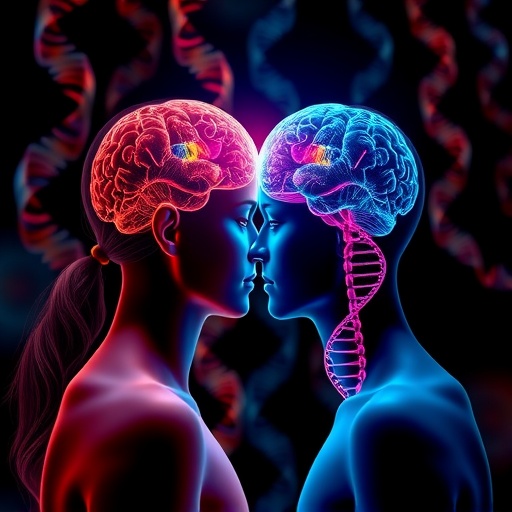In recent studies conducted on the Peromyscus californicus, also known as the California mouse, significant insights have emerged regarding the intricate links between sex differences in gene expression and the formation of long-lasting monogamous pair bonds. The ventral anterior cingulate cortex, a critical region for emotional regulation, social behaviors, and attachment, plays a pivotal role in these bonding processes. Researchers have focused on the presence of structural and receptor mRNA expressions within this particular region, and how these variations may affect the establishment and maintenance of monogamous relationships.
The significance of the ventral anterior cingulate cortex cannot be overstated. It has been implicated in various neuropsychological processes, including emotional memory, social interaction, and empathetic behaviors. Recent investigations reveal that male and female California mice exhibit distinct patterns of gene expression within this area, suggesting that hormonal influences paired with genetic factors contribute to the observed behavioral disparities between the sexes. These differences may reflect a biological underpinning for the divergent roles that males and females may adopt in the formation and maintenance of pair bonds.
At the molecular level, research highlights the role of specific receptor mRNA expressions in determining the behaviors associated with pair bonding. The presence of receptors for neuropeptides, such as vasopressin and oxytocin, presents a compelling angle for understanding the biological basis of social attachment. Males have shown higher expression levels of vasopressin receptors, which may enhance their inclination toward forming pair bonds and display protection over their partners. Conversely, females demonstrate a higher density of oxytocin receptors, which may facilitate nurturing behaviors and emotional connections to their mates.
Perineuronal nets, complex extracellular matrix structures that envelop certain neurons, emerge as potential players in modulating these bonding mechanisms. These nets are believed to provide stability to synapses, thereby influencing neuronal communication and overall brain plasticity, particularly during critical developmental windows. In the context of pair bonding, perineuronal nets may offer a structural substrate crucial for the enduring nature of these relationships. They are thought to regulate how synaptic connections form and strengthen in response to social experiences, thereby affecting the longevity of monogamous partnerships in California mice.
The presence of perineuronal nets varies significantly between the sexes, mirroring the observed disparities in mRNA expression levels. The implications of this structural variance extend to behavioral outcomes, emphasizing the need for a deeper understanding of how these nets interact with the underlying neurochemical systems in the ventral anterior cingulate cortex. It prompts scientists to explore the hypothesis that these nets not only stabilize neuronal connections but also serve as modulators of social behavior, potentially enabling the establishment of complex social structures.
A striking finding in the research is the timing of these molecular and structural changes. Males and females show different developmental trajectories in the expression of relevant genes, which may align with their different reproductive strategies. By investigating the developmental windows in which these differences manifest, researchers can gain insight into how environmental factors, alongside genetic predispositions, influence the social dynamics observed in monogamous pair bonding.
The interplay of hormones and caregiving behaviors is complex, as elevated levels of testosterone in males can correlate with aggressive tendencies, while estrogen can promote nurturing behaviors in females. This hormonal dichotomy informs how each sex navigates interpersonal relationships and the efforts made to maintain those bonds. Moreover, the intersection of hormonal influence with perineuronal net dynamics presents an exciting field for future research, particularly in the context of evolutionary strategies employed by monogamous species.
Understanding the genetic and structural underpinnings of pair bonding could also illuminate broader aspects of social behavior across other species. The similarities in neurotransmitter systems and receptor composition suggest conservation across phylogenetic lines, which may point toward a shared evolutionary adaptation for forming lasting social connections. As researchers continue to unearth the complexities of these relationships, there is a growing consensus that comparative studies among monogamous species could provide significant insights into the nature of emotional and social bonding.
Furthermore, these discoveries accentuate the relevance of studying animal models like the California mouse for human behavioral understanding. Much like the California mouse, human pair bonding and social attachments may be influenced by similar neurobiological frameworks. Investigating these underlying systems may not only enrich our comprehension of human relationships but also contribute to addressing social disorders characterized by attachment anomalies, such as autism spectrum disorders and various psychiatric conditions.
As research progresses, new methodologies continue to emerge, enhancing our capacity to explore the intricate relationship between genetics, environmental factors, and social behavior. Advanced imaging techniques and genetic manipulation tools foster innovative approaches to investigating neural circuitry involved in pair bonding. These approaches allow for real-time observation and intervention, bridging the gap between behavioral phenomena and neural activity.
In conclusion, the study of sex differences in mRNA expression within the ventral anterior cingulate cortex of the California mouse opens up a profound dialogue about the determinants of monogamous pair bonding. As researchers delve into the roles of hormone levels, receptor presence, and structural elements such as perineuronal nets, a clearer picture emerges of how these factors collectively orchestrate the delicate balance of emotional attachments and social interactions. The evidence gathered thus far lays the groundwork for a rich tapestry of future investigations, providing a promising pathway to greater understanding of both animal behavior and, ultimately, human social connections.
The intricate relationships between neurobiology and behavioral outcomes in monogamous species present an area rife with potential for discovery. By continuing to probe these fascinating dynamics, scientists can contribute to a deeper understanding of the evolution of social bonds, emotional attachments, and the biological imperatives that govern them. As the research community endeavors to unlock these mysteries, the California mouse stands as a critical model for exploring the intersection of gene expression, structural brain elements, and the formation of complex social bonds.
Subject of Research: Sex differences in structural and receptor mRNA expression in the ventral anterior cingulate cortex in relation to monogamous pair bond formation.
Article Title: Understanding the Sex Differences Driving Monogamous Pair Bond Formation in Peromyscus californicus.
Article References:
Image Credits: AI Generated
DOI:
Keywords: pair bonding, Peromyscus californicus, ventral anterior cingulate cortex, gene expression, perineuronal nets, monogamy, hormones, receptor mRNA, social behavior, neurobiology.
Tags: California mouse pair bondingemotional regulation and attachmentgenetic factors in social behaviorhormonal influences on behaviormale and female behavioral disparitiesmonogamous relationship formationneuropeptides and pair bondingneuropsychological processes in bondingreceptor mRNA expression in bondingsex differences in brain gene expressionventral anterior cingulate cortex function





